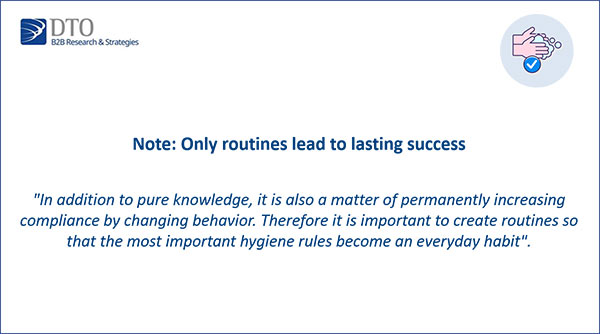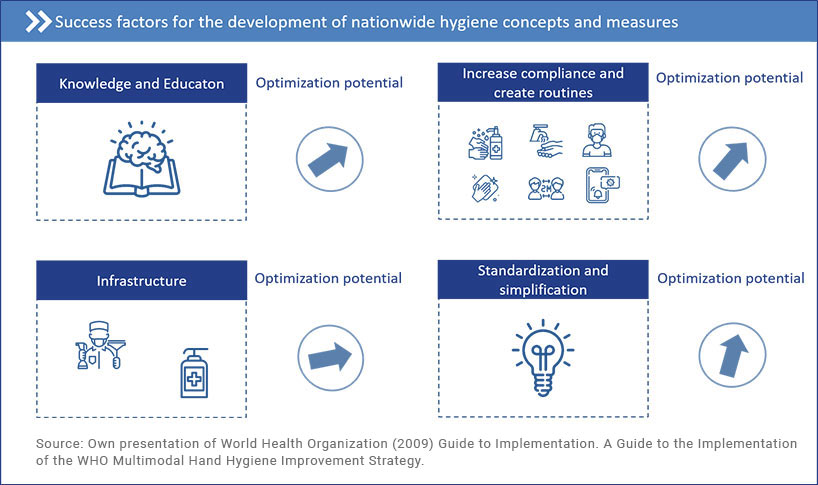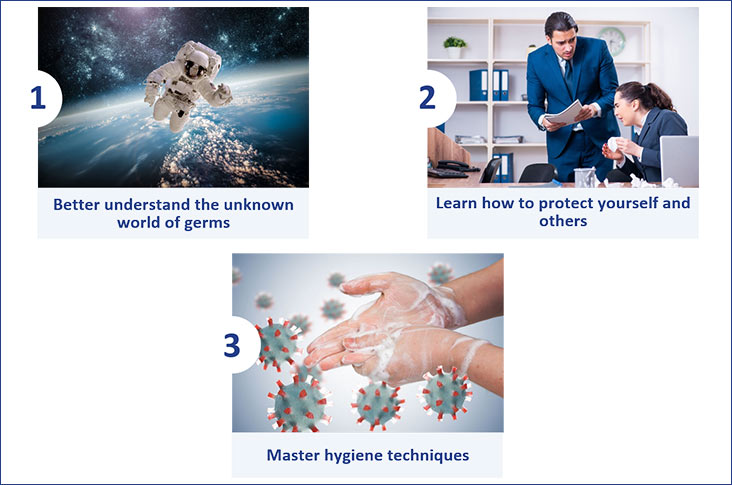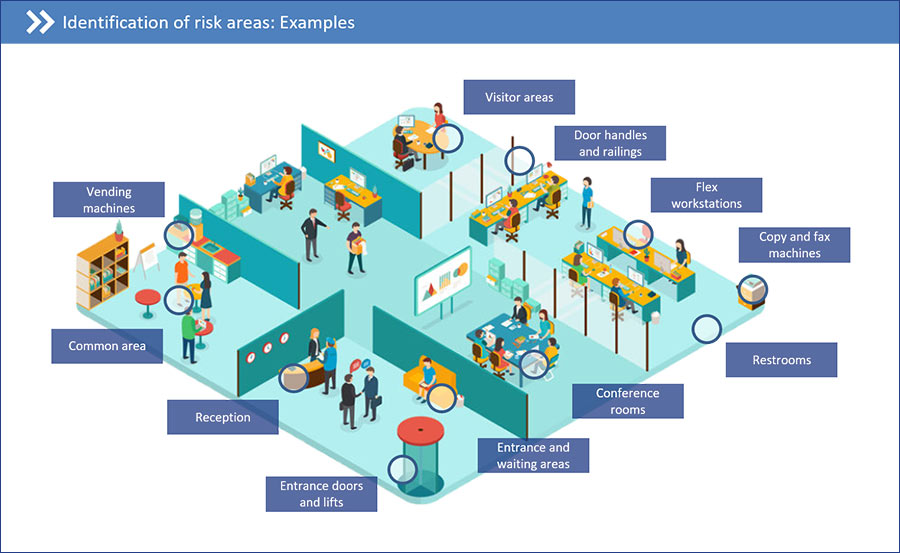
Development and Control of Hygiene Concepts in Pandemic Times
What we can learn and improve from the last months
The Corona Pandemic has been on our minds for several months now. After the nationwide lock-down, infection control measures were relaxed in many places in order to restore a certain normality. Thanks to the measures taken and the high level of compliance among the population with regard to infection prevention measures, the spread of the corona virus has been successfully slowed down for the time being. However, with the start of summer and the associated holiday trips and increased leisure activities, we are seeing how compliance with hygiene measures is degrading in many places. At the same time, the number of infections in Germany is also significantly rising again.
We want to take this as an opportunity to see what can be learned from the developments of the past few months and where there is potential for improvement. Particularly regarding a possible second wave of infection, it can be very helpful to take adequate measures more quickly in order to avoid a renewed lock-down. We know from past projects that successful infection preventions, such as hygiene concepts, are subject to certain success factors in order to work.

The basic principle of these findings, which were acquired in the health care system, can be transferred to other company types and to society. It can first be established that prevention is better than having to identify and interrupt infection chains through mass tests or app solutions. Nevertheless, both areas are key building blocks of an overall concept in the current pandemic. This brings up an essential point. Hygiene and infection prevention always work as a system. This can be illustrated very well using the example of a hospital. Even if 99 percent of all players adhere to infection prevention rules, even a very small percentage of people who do not follow rules is enough to cause an outbreak. Applied to the current situation, this means that even if 90 percent of all people adhere to hygiene rules, they could end up siting in a cinema, restaurant, or theatre with infected persons of the other 10 percent. Even though politicians repeatedly emphasize that most people adhere to hygiene rules, the system must work to keep the number of infections as low as possible.
Successful Hygiene Systems and How They Work
Functioning hygiene concepts essentially have four components of success, which can be imagined in as stages in an evolutionary process. All modules are interdependent on each other. If there are deficits in one building block, this can lead to the system not functioning properly. To illustrate this, we would like to give two examples:
- In a restaurant with a buffet, guests would like to disinfect their hands. However, there is no disinfectant for this. Here, compliance would be high, but the infrastructure would not be available.
- A person buys a disinfectant in a drugstore and applies it regularly, but with poor wetting results. The agent is not effective against corona viruses and only eliminates 99 percent of all viruses and bacteria. In this example, compliance would be high, a product would be available, but knowledge about the right product and the right application is not adequate.

Knowledge and Education as a Basis
We are now already at the first module "knowledge and education". This forms the basis for a functioning hygiene or infection prevention concept. A distinction must be made here between those who create and implement concepts, i.e. create the framework, and those who are to implement the corresponding measures or rules. The first category includes, for example, responsible politicians and corporate decision-makers, who primarily need the most important facts and information on how and why a concept/framework must or can be built. This building block should include answers to questions such as the following:
- Why is it important to deal with the topic of hygiene concept and infection prevention?/li>
- What must a concept contain and how is it structured?
- How should information be conveyed to citizens or employees in the best possible way or how should it be prepared?
- How can concepts be implemented across the board and how can compliance with the concepts be ensured?
In the case of citizens and employees, the primary aim is to create basic knowledge in the field of microbiology and, based on this, teach the most important hygiene rules and hygiene techniques. Since there was no acute need for this until now, there was a lack of training and teaching materials suitable for nationwide use, e.g. in schools or companies, when the pandemic began. This building block should include the following:
- The world of germs explained simply for everyone. For example, how do viruses and bacteria behave on animate and inanimate surfaces?
- How does hygiene and infection prevention work in private environments and at work?
- Which products should be used and how to apply them?
- How do the main prevention measures and hygiene techniques work?
- How can you practice techniques yourself and where can you find appropriate training material?

We know from many of our projects on the subject of hygiene, for example in health care or in the office environment, that the "knowledge and education" component is greatly underestimated, especially in Germany. We believe that we can safely control and implement the most important hygiene rules and measures, whereas studies regularly show the opposite picture. We would like to give a well-documented example from the healthcare sector. According to expert estimates, we have approximately 500,000 infections caused by hospital germs in Germany every year, resulting in approximately 15,000 deaths. About one third of these could be prevented by better hygiene.
That is why we see a high potential for optimization, especially in the areas of "knowledge and education" in Germany, also with regard to a second wave of infection. In addition, there is also another very elementary point that we know from the field of corporate management. If measures, e.g. in restructuring or cost optimization programs, are not sufficiently explained or not understood, resistance often arises. Non-uniform infection prevention rules, unnecessary debates on relaxation and a lack of information have also led to uncertainty in the current pandemic and negative attitudes in parts of the population regarding infection prevention and hygiene rules.
Standardization and Simplification
We have now come to the next point, "standardization and simplification", which is necessary for a functioning hygiene and infection prevention concept. Concepts must be as standardized as much as possible and kept very simple. This is particularly important to create a general understanding, to facilitate the establishment of routines and to be able to implement and control concepts across the board. Since we do not have a uniform level of knowledge about hygiene and infection prevention in Germany, it is important to create understanding of the topic and the most important short-term measures to the most people possible. Studies in recent months have repeatedly shown that many measures in country regulations are not understood because they are either formulated too complicated or simply too confusing. In order to achieve a sustainable learning effect for future pandemics or disease outbreaks, e.g. the annual wave of influenza, and to implement hygiene measures on a permanent basis, a strong simplification and standardization of regulations is necessary. This also has the effect of increasing compliance and minimizing resistance to the measures. The AHA formula published by the Federal Ministry of Health is well-intended, but for various reasons it does not work. Standardization exists and in many cases the necessary infrastructure is also available, but there are deficits in knowledge, routines, technology (e.g. hand disinfection and hand washing) and compliance. Masks are an exception in compliance. These are worn properly by the vast majority of people.
The Development of a Hygiene Infrastructure
As the next building block, we want to address is the topic of infrastructure. This refers to the availability of hygiene products (e.g. dispenser systems and consumables) at the places where they are needed. Examples of this are the disinfectant dispenser at the entrance of the supermarket or the soap dispenser in the washroom of a school. Within the framework of a hygiene or infection prevention concept, risk areas would be identified, as in the diagram on the right, and the appropriate infrastructure would be created for these areas. This is where the greatest improvements can be seen in Germany. In schools, the infrastructure has been renewed or greatly optimized in many cases and in other areas, such as airports, railway stations or supermarkets, new infrastructure has also been created. It is unable to say whether this development will be sustainable and which of these infrastructures will remain after the Corona Pandemic. During the swine flu epidemic there was already a strong optimization in this area, which ended up not being sustainable. That being said, experts assume that Corona will have a lasting positive effect on the hygiene infrastructure in some areas.

Implementation in Everyday Life
The last module deals with the implementation of hygiene concepts. Here it is a matter of selecting the right measures and ensuring compliance with them. If all previous modules have been sufficiently taken into account when creating the hygiene and infection prevention concepts, measures can be flexibly implemented as required. In general, the most important measures for a hygiene and infection prevention concept are correct hand and surface hygiene, social-distancing, and sufficient ventilation. In the event of a corona pandemic, this is supplemented by wearing a mouth and nose protector, isolating infected persons, using the corona warning app and a corresponding test strategy. A very essential factor for this component is the creation of routines. This means that basic hygiene measures, such as proper hand hygiene (How? When? With what?), become part of daily habits. It is therefore not only a matter of imparting knowledge and providing infrastructure, but also a matter of clever concepts to ensure that the measures are adhered to in the long term. The WHO assumes that the creation of routines and the associated system changes can take years. This is not necessarily uncommon as we have been observing the same pattern of implementing routines for years in our own studies in the healthcare sector, as well as also in other sectors.
Conclusion and Recommendations for Action
In our conclusion, we would like to critically review and evaluate the current situation on the basis of this article’s findings and thereby develop some "lessons learned". In Germany, with the beginning of the corona pandemic, the implementation of hygiene and infection prevention concepts began early on. The corona situations in China or Italy, among others, quickly pinpointed the need for action, and the direct awareness of the population and acceptance of the protective measures was enormously high. Because the measures were implemented very strictly, the spread of the virus was quickly slowed down. However, the time between the first implementation of the measures and the later easing of them was not optimally used. In this case, much more intensive work would have been required in the transfer of knowledge or education and the establishment of routines. A uniform approach to the development of hygiene concepts and a significant simplification of regulations and their communication would also have been helpful. If one assumes that, as described, hygiene functions as an evolutionary concept and can bring lasting benefits, then opportunities were missed. If we look at the most prominent disease outbreaks of the last 20 years, it quickly becomes clear that SARS-CoV-2 will not be the last virus we have to deal with. The current corona pandemic and the initially high level of public awareness could have been used to build up sustainable knowledge and implement suitable structures across the board. The importance of infection control and hygiene could have also been significantly increased. In many areas, hygiene is still predominantly seen as a cost factor. That being said, the costs of sickness-related absences during flu season are also enormous for companies.

Hygiene as a Closed System
Furthermore, an additional, and very significant, error was made. Hygiene only works as a system and should be understood and implemented as such. In Germany, exactly the opposite has been done and focus was placed primarily on individual measures. This becomes particularly clear when you look at the regulations of the state governments, which try to describe a solution for every situation in detail. This is certainly understandable and comprehensible from a political point of view, however, contradicts the basic functioning of hygiene systems. These must be kept as simple as possible and include everyone involved. This is the only way to ensure a high level of compliance in the long term.
With regard to a second wave of infection, a clear recommendation for action is not easy to derive. It is likely to be difficult to start implementing adequate education measures retrospectively, as the sensitisation rate of the population is by far not as high as it was at the beginning of the pandemic. Some people now also have a rather negative attitude towards hygiene and infection prevention. It might therefore make sense to ensure compliance with existing measures as best as possible and to work on a long-term strategy for the nationwide optimisation of hygiene and infection prevention concepts in order to be better prepared for the next pandemic.
To help companies in this dynamic situation, we have identified the most important topics for them in our practical hygiene workshop.
Text written by Michael Di Figlia
Would you like more information on this topic or are you interested in a market analysis please get in touch with us. Our offices in Germany and Singapore are available for a free and non-binding consultation.